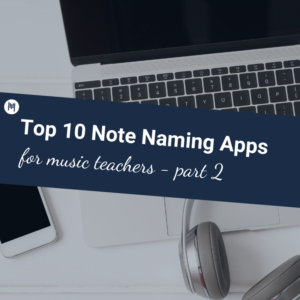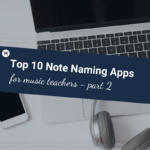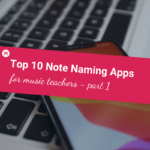
Guest author: Steve Giddings
This article has been written by a guest author. If you’re an educator or music industry professional who is interested in contributing an article to the Midnight Music blog, you can apply here.
A Quick Guide to RunningSoundin AnySituation
So you have your degree in Music Education and you find out at your first teaching job that you are solely responsible for running the sound system. Oddly enough, you’ve never been within 10 metres of a sound board and have no idea what you need or what to do. This handy, quick-guide will give you the basics of each kind of setup and then show you the basics of what you need to know about asound system and a mixing board.
Types of Setups
The gear you will need will depend on each “sound scenario” and can range from very basic to more advanced. Here are the basics for each kind of setup:
1. An audio/video presentation for an assembly
Assuming the presenter has the laptop and the projector, you will need: 1 speaker with AV andmicinput, 1 microphone with stand, and XLR cable, and 1 male AV to male 1/8”cable.
2. A Choir Performance
Depending on the group, you may need a solomicor an accompanist. Here are some common scenarios:
- A smallacappella choir:At least two overheadmicseither condensers or hybrid vocalmicswith stands, mixing board with 2 main speakers.
- A small choir with instrumental accompaniment:At least 2 overhead condenser or hybrid vocalmicswith stands, a mixing board with 2 main speakers.
- Alarge children’s unison or 2-part choir concert with live piano accompaniment:at least 2 overhead condenser or hybrid vocalmicswith stands, a mixing board with 2 main speakers. There may also need to be acondenser microphone aimed inside the piano for volume. If you are using a keyboard with an amplifier, you can do it without any additional gear as long as the pianist and the choir can hear the accompaniment. Most electronic pianos have onboard speakers that don’t turn off when plugged into an amp. If there are soloists they will need their own vocal microphone with a stand.
- A large children’s unison or 2-part choir concert with instrumental tracks:It becomes more complicated sound-wise with instrumental tracks, since you will need to ensure that the instrumental tracks are heard by both the audience and the choir members. You will need a mixer, 2 main speakers, at least 2 floor monitors (for foldback), at least 2 condensers orhybrid vocal microphoneswith stands and XLRs, the sound source (laptop, iPod), a dual male mono 1/4” to male stereo 1/8” cable.
3. Jazz Ensemble
- Big Band:At least one solomicfor each horn section (saxeswill likely need two), a mixer with 2 main speakers, amplification for each electronic instrument (guitar, bass, keyboard). You will likely not need monitors.
- Small Combo:Depending on the melody instrument, it may not need anything.It may also depend on the venue.
4. Stage Musical
For a musical, you will need enough wireless headset microphones for those with lead roles or secondary roles, a mixer, 2 main speakers, at least one monitor,adual male mono 1/4” to male stereo 1/8” cable for instrumental tracks. For a live orchestra, all instruments will need to bemic’d.
5. Rock Ensemble
Since rock ensembles and popular groups are made up of mostly electronic instruments and vocalists, this is the most extensive setup you will come across. You will need: a mixing board, 2 main speakers, a bass bin, at least 2 floor monitors, enough vocalmicsfor your singers or horn players, amplification for your guitars, bass, and keyboard, a DI box for your bass, acoustic guitar, and keyboards, an instrument microphone for your guitar amplifier. Othermicingoptions are at least 2 overhead condenser microphones for each drummer and a bass drummicfor each bass drum. Basically, everything ismic’dor amplified for a group like this.You may also want to mic the guitar amplifiers using an instrument microphone.
Types of Sound Systems
There few different setups for a sound system but I am only going to discuss the two most common that you would likely come across:
1. Powered mixer with unpowered speakers
Withthis setup, the mixer will usually be bulky and heavy with awattage ratingon the back and is the only piece that needs to plug into the outlet.Thespeakers that go with these mixers have no voltage rating and don’t need to plug into an outlet—they draw their power from the mixer.
An advantage of this setup is that you only need one outlet for the entire system. Even if you add more speakers for monitoring purposes, they alldraw their power from the mixer because the amplifier is built-in. This makes it pretty easy to set up anywhere.
A disadvantage is that it can become very difficult to add speakers unless you know a lot aboutwattage and voltage. Unpowered speakers have an ohm rating and unless you know the ratingof each piece of equipment, it can be difficult to mix-and-match. Many powered mixers, though, have an unpowered section for speakers at the front of the unit.
2. Unpowered mixer with powered speakers
Withthis setup, the mixeris lighter and has no wattage rating. There are usually faders instead of knobs for output volume. The speakers will have an on off button and you will have to plug them in.
An advantage of this system is that you can mix-and-match with ease. Each speaker has its own wattage and have built-in amplifiers.
A disadvantage of this system is that you need access to power outlets for every piece of equipment you plan to use. Every mixer and speaker will require its own power source.
Troubleshooting tips
There are a number of things I wish I knew when I started working with sound for the first time. Don’t make the same mistakes I did! Here are some common issues that arise with sound:
- Just because your speaker goes to 10 does not mean that it should ever go to 10: using the top setting canblow your speaker. You never start to run a marathon at full tilt because you will tire out much quicker.
- Speech is different from singing: understanding speech relies on the high frequency sounds in wordslike T and S.“Testing 1-2-3” isn’t just a thing you say into a microphone—it is designed to help test the sound across all frequencies.Adjust the highfrequency knob on that channel if you find speech is mumbled.
- Gain vs volume: Gain ishow much comes into the mixer and volume is how much gets out.There is a balance between the two. Some inputs will need more gain while others will need very little.
- The “Prison guard” and “Gate keeper”:If you think of the mixer as a “prison guard” and the speakers as the “gate keepers” it will help you understand the basics of how sound works.
- Phantom power: Regular vocal and instrument microphones work without phantom power. Most condensers and some other types of microphones need phantom power.Look for the 48v phantom power button at the top or the back of your mixer if everything is set up properly but the microphone is not working.
- Music that pans left and right: if you are using a recorded example which hasmusic that pans left and right through your mixer (such as the Macmillan Share The Music series), you will need the 1/8”male stereo to dual male 1/4” mono cable.A 1/8” stereo to dual male RCA will work too but you won’t be able to control its volume separately from the rest of the mix.
- “Headphone out” is equivalent to “speaker out”: If you see a headphone jack on an instrument like a keyboard, you can use that to plug the instrument into the mixer or into the DI (direct input box).
- Monitors: Monitors plug into aux outs and can be controlled separately from each channel. All performers need to hear themselves – including kids so if you are using a backing track or any type of accompaniment in a performance, monitors are essential.
- How much amplification? As a general rule, the larger the room, the more amplification you will need.
Setting up Your First Sound Board
Okay, Steve, great—but where do I plug everything in?In this diagram, I showhow sound for a rock group would be set up. As mentioned, this would be the most extensive setup you will use—everything else is a pared down version of this.
To Conclude
Sound can be intimidating, but it doesn’t have to be. Let this handy guide be your coach in any situation you may come across in a school setting. At the very least, it may help you bypass a few steps in the learning process. In the end though, the best way to figure out a sound system is through trial-and-error.Until next time, HappyMusicking!
About the author














One Comment
[…] a win-win situation. I’ve written guest posts for a number of websites including MusicalU, Midnight Music, Professional Music Educator, and APME. Sometimes sites put out a ‘call’ for guest blog […]